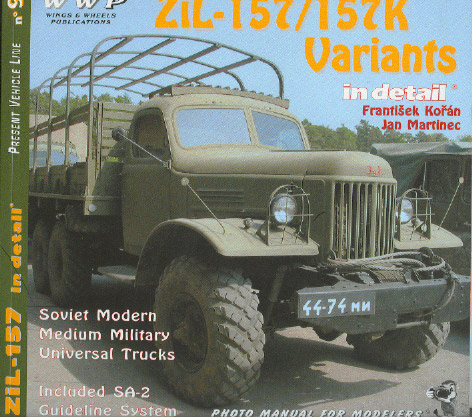Wings and Wheels Publications Present
Vehicle Line No. 9; ZIL-157/157K Variants in Detail
by Frantisek Koran and Jan Martinec

Wings and Wheels Publications, Prague, Czech Republic, 2004;
120 pp. with about 400 color photos; price L16.99 (about US $30.50); ISBN
80-86416-36-4
Advantages: Clear, sharp photos make this book a must for
building the current line of ZIL-157 kits from Trumpeter; good coverage
of the SA-2 GUIDELINE, its launcher and transporter
Disadvantages: finding a source for this book is a bit harder than some
other lines
Rating: Highly Recommended
Recommendation: for all softskin and Soviet era fans, as well as surface-to-air
missile buffs
The Soviet Union was a pretty forward thinking place in regard to tanks
and SP guns, but woefully backward in the area of trucks and transportation
in general. When they received the first series of US trucks under Lend
Lease in 1942, they were amazed at both the sophistication of American
trucks and their reliability and ruggedness. Their own standard medium
truck, the ZIS-5, was a 4 x 2 design with brakes only on the rear wheels
and noted for only limited off-road capability. The GMC CCKW and Studebaker
US6 with their 6 x 6 configurations and reliable drivelines and brakes
were a shock.
After the war, the Soviet truck industry built its own version
of the two American trucks as the ZIS-151. This truck remained in production
from 1948 to 1957 (changing names from ZIS – "Stalin"
Factory – to ZIL – "Likhachev" Factory – after
1953) when the ZIL-157 took its place. This truck was an improved version,
with its main distinction being the large, single tires in place of the
smaller, narrower ones that were paired on the rear drive axles of the
ZIL-151. These also had adjustible tire pressure to both overcome flats
as well as increase flotation in soft terrain. Later, an automatic control
was provided that did this automatically. The ZIL-157 was in production
from 1958 to 1961; the improved K model from 1961 to 1964, various other
improved models later taking its place. The last variant, the ZIL-157KD,
was in production from 1976 to 1982. Most of these were export models
(the USSR having changed over to the ZIL-131 in the meantime.)
The ZIL-157 was basically a 3 metric ton cargo truck meaning
it had a cross-country cargo rating of 3,000 kilograms or about 6,615
lbs. On paved roads this could surge to as much as 7,500 kilograms plus
a trailer, but for the most part the vehicle was not strained that heavily.
It had a crew of two and could carry a normal load of 12-16 soldiers in
the rear cargo body thanks to folding seats. The vehicle was provided
with a self-recovery winch.
Numerous variants were built, the most common being the
so-called "BBV" (Box Body Vehicle) versions and the ZIL-157V
model tractor for use with a semitrailer.
WWP produces great photo studies of former Soviet equipment
that was used or was present in Czechoslovakia, and this book is no exception.
It provides the following detailed coverage: 36 pages on the base model
ZIL-157/ZIL-157K; 9 pages on the ZIL-157V tractor; 18 pages on the PR-11B
missile transporter semitrailer; 26 pages on the V-750 (SA-2) missile
and its launcher; 8 pages on a BBV variant; 6 pages on the P-15 (FLAT
FACE) radar variant; 6 pages on a BBV used as a simulator for 9M14 (AT-3)
training; and two pages on a locally built snowplow variant.
As with all books of this sort, the pictures are large,
crisp, and in color, with "sort of" English text (grammar can
get, um, interesting.) But the authors differentiate between detail differences
and make the books eminently worthwhile, especially if modeling the subject.
The section on the SA-2 is not too useful for the missile
and the various versions, but it has great shots of the launcher, including
open access hatches showing the internal parts of the launcher and how
the layout of the components works out. If anyone wanted to make a dynamite
model of the Trumpeter kit, this is a must for reference.
Likewise the other major kit, the semitrailer transporter.
Although the book does not show the loading process (the missile on its
transporter rail is swivelled so it can slide rear end first onto an empty
launcher rail) there is a good deal of coverage of the turntable and the
various bits and fittings that should permit an average modeler to show
one being loaded with little trouble.
Overall, these books are good value and in many cases very
much provide what is the only reference for modelers of a specific subject.
Cookie Sewell
|